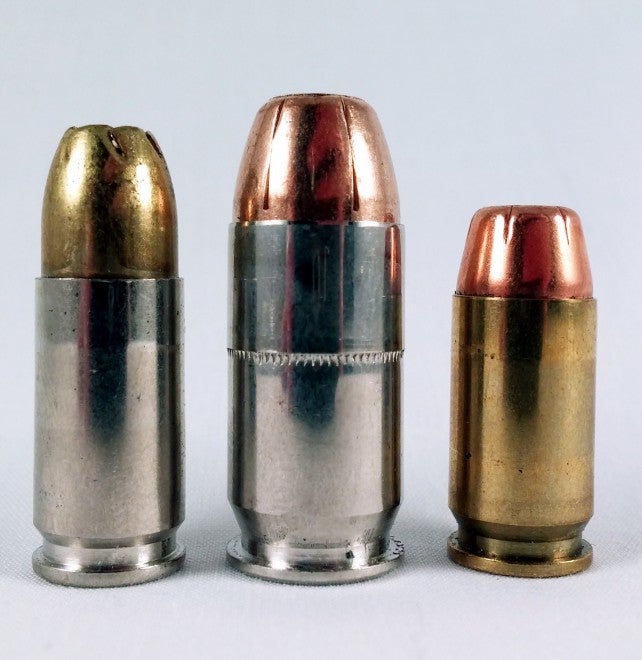I received this email from a reader a little less than a week ago:
Hi! I’d love to see a series of articles on the advantages and disadvantages of the various pistol calibers from the perspective of the concealed carrier. There’s a lot of conflicting opinions around for those of us who are trying to choose a caliber and don’t have trouble with the recoil of any.
Thanks.
Robert C.
Your wish is my command, Robert. I will be happy to give a short run-down of my current understanding of pistol caliber effectiveness. My readers should note, though, that there are still things to learn on this subject, and I am not an accredited expert. Still, I’ve done quite a bit of reading in this area, so I feel reasonably confident presenting the following.
FBI Firearms Training Unit Chief John C. Hall wrote, in the forward of the 1989 paper Handgun Wounding Factors and Effectiveness:
The selection of effective handgun ammunition for law enforcement is a critical and complex issue. It is critical because of that which is at stake when an officer is required to use his handgun to protect his own life or that of another. It is complex because of the target, a human being, is amazingly endurable and capable of sustaining phenomenal punishment while persisting in a determined course of action. The issue is made even more complex by the dearth of credible research and wealth of uninformed opinion regarding what is commonly referred to as “stopping power”.
Handgun Wounding Factors identifies four mechanics of ballistic wounding:
- Penetration, the length of tissue through which the projectile passes,
- Permanent Cavity, the volume of tissue that has been destroyed by the projectile as it passes through,
- Temporary Cavity, the temporary expansion of the permanent cavity by stretching due to the transfer of kinetic energy of the projectile,
- Fragmentation, projectile pieces or fragments that are impelled outward, which may sever blood vessels, muscles, arteries, etc.
However, Handgun Wounding Factors notes that this last, fragmentation, typically does not occur in pistol calibers as the velocity of pistol rounds is too low to facilitate it with projectiles that provide adequate penetration. In addition, the effect of the temporary stretch cavity on the human anatomy is secondary at best, if not insignificant. Pistol calibers therefore wound primarily through the first two mechanisms, penetration, and the permanent cavity. In other words, the basic terminal effectiveness considerations for the civilian when choosing a handgun round should be: “how deeply does this round penetrate, and what volume of tissue does it crush along the way?”
The current state-of-the-art technology for achieving the optimum balance of these characteristics for handgun calibers is the jacketed hollow point bullet. This is a bullet featuring an empty cavity in the nose, which creates forces on the bullet’s core and jacket when penetrating the target, causing the bullet to expand into a wide flower-like shape which crushes the maximum amount of tissue. This allows a much wider permanent cavity than the size of the bullet (and therefore complete round) would suggest, and also helps prevent over-penetration, reducing the risk to innocent bystanders.
Although I have given this simple distillation of the problem, it is still, as Chief Hall said, a complex issue. An example of this complexity is given in the 2012 paper Physical Mechanisms of Soft Tissue Injury from Penetrating Ballistic Impact:
The results show that bullets of the same caliber can have very different wounding potentials based on penetration into 10% ballistic gelatin. Sometimes bullets pass through intermediate barriers such as heavy clothing, wood, metal, wallboard or auto glass before penetrating tissue. In such situations, the bullet tip can be altered, changing its penetration and energy loss characteristics in tissue [44].
Sometimes these changes may be unexpected. For example, when the 127 grain Winchester Ranger SXT (Fig. 2B) passes through steel, its penetration depth in gelatin increases from about 36 cm to 43 cm. Its tip is compressed as it passes through the steel so that it does not expand much in the gelatin and does not lose as much energy as quickly. In this example, the force-penetration profile (and resulting wounding) will look more like that of a 9mm FMJ (Fig. 2A) that has not passed through an intermediate barrier.
In other words, the penetration and permanent cavity of a given projectile are interrelated. A projectile that does not expand has less resistance, and will penetrate deeper, while one that expands to a great degree will have more resistance, and penetration may suffer. Further, calibers that produce less energy, such as for example the .380 ACP, do not have as much force behind the bullet, and their penetration while expanded can suffer as a result. Calibers that produce more energy, such as the .357 Magnum, for example, may have surplus force and can overpenetrate even if good bullet expansion is achieved.
So then, what is desired is a caliber that has enough energy to expand to the maximum possible diameter, while still penetrating to the desired depth. For most people, that “desired depth” is the FBI standard of 12 to 18 inches in ballistic gelatin, and I can think of no reason to argue with that figure. In concert with this, we need a bullet design that gives the maximum expansion at the operating velocities of that cartridge given the barrel lengths of common platforms, and the best consistency of expansion through common barriers such as auto glass, sheet metal, plywood, denim, and especially human ribs.
Next time, we’ll take a look at how these considerations shake out with regards to common calibers and projectile designs, so be sure to check TheFirearmBlog.com for more!
 Your Privacy Choices
Your Privacy Choices
